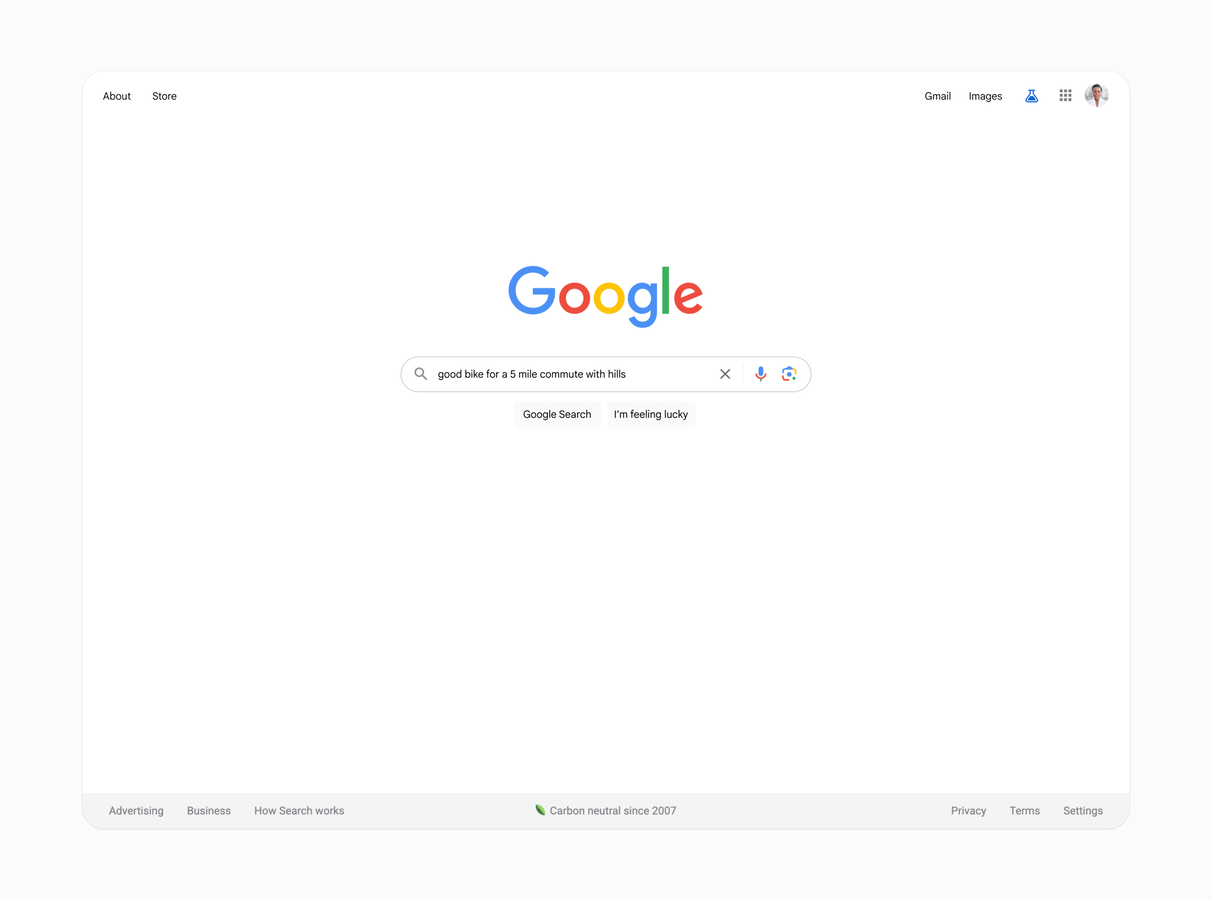The digital marketing world is on the brink of another major shift with the introduction of Google's Search Generative Experience (SGE). This innovative AI-driven feature promises to redefine SEO and PPC advertising, offering new opportunities and challenges for marketers.
While details about Google's SGE are still emerging, we're here to break down what is search generative experience, its potential impact on search and digital marketing strategies, and what it means for your business.
What is SGE?
Search Generative Experience or SGE, marks a significant departure from traditional search engine operations. Instead of the familiar list of links, SGE aims to provide interactive and user-centric search results. This means delivering immediate answers within the search results page itself, reducing the need for users to click through to websites.
With SGE, search results will be more interactive and focused on the user, not on the SERP. SGE will offer immediate responses and information within the search results themselves, removing the need for consumers to click on links to find what they're looking for. This is an alternative to merely depending on click-throughs to websites.
For example, an SGE search query like "What's the best national park for a family with young kids and a dog?" would directly display comprehensive, interactive answers, allowing users to refine their search or get more information without leaving the search page.
How Does SGE Work?
Instead of simply returning a list of links, SGE understands the user’s intent and delivers AI-generated, conversational summaries designed to accelerate discovery and exploration. Here's how it works step-by-step:
.png?width=696&height=726&name=unnamed%20(64).png)
1. Query Understanding with AI
When a user enters a search query, especially complex, long-form, or multi-intent questions, SGE leverages advanced large language models (like PaLM 2 or Gemini) to:
- Understand the full context and intent of the query, not just keywords.
- Break down multi-step questions into core components.
- Interpret natural language input the way a human assistant might.
This enables SGE to deliver highly relevant, synthesized results that go beyond traditional keyword matching.
2. Generative Snapshot (AI Summary)
For eligible queries, SGE generates an AI-powered summary box at the top of the SERP. This “snapshot”:
- Synthesizes key insights from multiple high-quality, credible sources.
- Presents the information in natural, conversational language, making it feel like a chat-based response.
- Often includes step-by-step instructions, bulleted lists, or concise definitions.
- Features links to the original content, promoting transparency and encouraging users to dig deeper.
This feature reduces the need to click through multiple pages to find answers, especially useful for exploratory searches or comparisons.
3. Interactive Follow-Ups
One of SGE’s key innovations is its conversational interface, which allows users to:
- Ask follow-up questions without rephrasing or starting over—SGE maintains the context.
- Explore suggested next steps or related topics, fostering a more fluid and intuitive search journey.
- Treat search like a dialogue, not just a transaction—ideal for users who want to go beyond surface-level answers.
This positions SGE as an AI search assistant, not just a results engine.
4. Source Attribution
To maintain trust and uphold Google’s focus on E-E-A-T (Experience, Expertise, Authoritativeness, Trustworthiness), SGE:
- Cites the web pages it draws from, often linking directly to those sources.
- Displays attribution clearly beneath the snapshot to promote content credibility and publisher visibility.
- Helps users verify information and supports ethical content usage.
This is especially important for businesses and content creators aiming to maintain organic traffic and recognition.
5. Continuous Learning & Improvement
SGE isn’t static—it evolves continuously through:
- User feedback and interaction data help fine-tune relevance and accuracy.
- Advances in AI and search algorithms, such as improvements to Gemini or better real-time indexing of web content.
- Updates to how Google interprets and ranks content, especially in response to content quality signals and user intent trends.
This means the experience will continue to improve as more users engage with it.
What Makes up Google SGE?
Google’s Search Generative Experience (SGE) is made up of several interconnected components that blend traditional search with generative AI capabilities to create a more conversational, intuitive, and content-rich experience. Here’s a breakdown of the key elements that make up Google SGE:
1. AI-Powered Snapshot (Answer Summary)
- This is the main feature users see at the top of the results.
- It synthesizes information from multiple high-authority sources into a concise, natural-language summary.
- The snapshot often includes:
- Bulleted or paragraph-style answers
- Key facts or how-to steps
- Links to original sources for transparency
2. Source Citations and Web Links
- Google provides clickable citations to the sites used in the summary.
- This helps users verify the information and drive traffic to original content, critical for publishers and brands.
3. Follow-Up Questions & Conversational Interface
- Below the AI snapshot, SGE offers related follow-up questions.
- Users can also ask their own follow-ups, and the system will continue the conversation with context retention, like a chatbot.
- This encourages deeper exploration, rather than one-off searches.
4. Interactive Product and Shopping Results
- For commercial queries (e.g., "best noise-canceling headphones"), SGE shows:
- AI-curated product comparisons
- User reviews, specs, and pricing
- Links to eCommerce sites
- It integrates Google Shopping Graph data with generative summaries.
5. Visuals and Rich Media
- Depending on the query, SGE may include:
- Images
- Videos
- Product carousels
- These enhance engagement and visual understanding, especially for "how-to" or product-related queries.
6. Ads & Sponsored Content
- Google is testing sponsored placements within or adjacent to SGE snapshots.
- These ads are clearly labeled and contextually relevant, blending paid search with generative insights.
7. Generative AI Models (Under the Hood)
- Powered by large language models like Gemini or previous versions like PaLM 2, trained on vast datasets.
- These models:
- Interpret query intent
- Generate human-like summaries
- Choose which web results or data to surface
How to Turn on Google SGE
Before turning on Google SGE, it’s important to note that this feature is still experimental and may not be available to all users or in all regions. Access is typically granted through Google’s Search Labs, where users can opt in to test new AI-driven search capabilities. Here is how to turn it on for Mobile and Desktop:
On Mobile (Google App)
- Update your Google app to the latest version (iOS or Android).
- Open the Google app.
- Tap your profile icon (top right).
- Select “Search Labs” from the menu (if available in your region/account).
- Find “SGE (Search Generative Experience)” and tap the toggle to turn it on.
- Tap “Try it out” to begin using SGE in your searches.
On Desktop (Chrome Browser):
- Make sure you’re signed in to your Google account.
- Open Chrome and go to: https://labs.google.com/search
- If available to you, you’ll see the Search Labs dashboard.
- Find the SGE experiment, and click the toggle to enable it.
- You can now start using SGE in your Google searches.
Benefits of Google SGE
Google SGE introduces a more intelligent, conversational search experience that helps users find information faster, explore topics more deeply, and interact with results in a more intuitive way, offering significant advantages for both users and content creators.

Faster, Smarter Answers
SGE delivers concise, AI-generated summaries that answer complex or multi-part questions instantly, minimizing the need to open multiple tabs or compare conflicting sources.
- Example: For queries like “What should I consider when buying an EV?”, users receive key considerations, comparisons, and even product suggestions in one snapshot.
More Context in Less Time
Instead of scanning pages of results, users get a synthesized overview sourced from multiple authoritative websites. This provides greater clarity and depth with less effort.
- Ideal for research-heavy or decision-making queries where users want quick understanding without sacrificing accuracy.
Conversational Exploration
SGE makes search more dynamic and user-friendly by allowing natural follow-up questions. The AI retains context across queries, mimicking the flow of a live conversation.
- This approach supports a richer, more intuitive exploration process—ideal for users digging into layered or unfamiliar topics.
Better Product Research
For commercial searches, SGE integrates real-time product data, specs, reviews, and pricing, streamlining decision-making and enhancing buyer confidence.
- Product comparisons are AI-curated, making it easier to evaluate options side-by-side.
Enhanced Visibility for High-E-E-A-T Content
SGE prioritizes trustworthy, experience-backed content when generating answers. Websites that demonstrate Experience, Expertise, Authoritativeness, and Trustworthiness (E-E-A-T) are more likely to be cited.
- Insight: Businesses must adopt adaptive SEO strategies that highlight expertise and relevance, not just keywords.
Increased Click Potential from Source Citations
Even though summaries are AI-generated, Google includes clickable citations to original sources, driving referral traffic and supporting publisher visibility.
- Creating content that answers real user questions boosts the chances of being featured and linked.
Opportunity for Differentiation
Brands that publish unique, in-depth, and value-driven content, especially in underserved or niche areas, can gain disproportionate visibility in SGE summaries.
- This levels the playing field for smaller or specialized businesses that produce high-quality, relevant content.
Deeper Audience Engagement
Because users can explore more nuanced, long-tail queries through follow-ups, SGE promotes extended engagement and content interaction.
- This opens up opportunities for businesses to align content strategies with deeper questions that nurture leads and build authority.
Insights into User Intent
Follow-up suggestions and conversational threads give real-time insight into what users are really looking for, offering valuable data for content planning, SEO, and paid ad strategies.
- Marketers can use these insights to refine messaging, target long-tail keywords, and improve campaign relevance.
SGE Impact on Conversion Rates and Website Traffic
This shift towards providing answers directly on the search results page could significantly affect website traffic and user engagement. Traditional SEO and PPC strategies may need to evolve as the way users interact with search results changes since, regardless of the search query, the user is going to see answers and prompts where they can continue to click through and refine their query or get more information - without ever leaving the search result or landing on a website page.
Here's another example of an SGE search for purchasing a new bike:

Early Adoption and the Challenges of Google SGE
While the potential impact of SGE on search and digital marketing is enormous, it is essential to acknowledge that widespread adoption may not happen overnight. Looking at past advancements like voice search and Google Assistant, we can draw valuable insights as they gained the attention of marketers but did not see immediate adoption among the general public. This highlights the need for patience and a cautious approach when it comes to SGE.
In addition to potential delays in user adoption, there are specific challenges associated with SGE, particularly in terms of the accuracy of its responses, especially for proximity-based searches. Furthermore, it appears that SGE may not cater to all types of queries, indicating a coexistence of conventional search experiences alongside SGE experiences, at least in the near future.
How SGE Will Influence Advertising Strategies
With SGE, the focus of advertising strategies is expected to shift. Advertisers must be prepared for a significant shift in click-through rates (CTR), which will impact their results. Google Ads representatives are already placing more emphasis on metrics such as cost per action (CPA) and return on ad spend (ROAS) rather than CTR. While this transition may not lead to significant changes in actual performance metrics, it will undoubtedly influence advertising strategies.
Looking ahead, we anticipate a closer collaboration between PPC and SEO specialists. The evolving landscape of SGE will emphasize the importance of seamless coordination between these specialized marketing disciplines, all with the aim of delivering intent-rich experiences for users.
How to Optimize for Generative AI
To ensure your content is discoverable and featured in AI-generated summaries like Google SGE, it’s essential to optimize for generative AI by focusing on credibility, structure, and user intent. Here are the key strategies to help you do just that.
1. Focus on E-E-A-T: Experience, Expertise, Authoritativeness, Trustworthiness
- Build topical authority with content that reflects real-world expertise.
- Use author bylines and bios that highlight qualifications.
- Include first-hand experience, case studies, or insights—especially for YMYL (Your Money or Your Life) topics.
Tip: Use structured bios, link to LinkedIn profiles, and include credentials where applicable.
2. Answer Real, Complex User Questions
- Generative AI thrives on natural-language, intent-driven queries.
- Create content that answers:
- “How to…”
- “What’s the best way to…”
- “Why does…” or “What should I consider…”
Use tools like People Also Ask, AnswerThePublic, or Google Search Console’s Queries report to source questions.
3. Use Structured, Scannable Content
- Break content into clear sections, use H2/H3 headers, and bullet points.
- Summarize key points early—AI models prefer concise takeaways.
- Add FAQs at the end of pages to answer common, conversational queries.
4. Optimize for Semantic Search (Not Just Keywords)
- Use related concepts, synonyms, and contextually relevant terms.
- Create topic clusters and interlink related content.
- Map your content to user intent, not just search volume.
Example: Instead of just “digital marketing services,” include variations like “how to grow online with digital marketing,” “SEO for small businesses,” etc.
5. Implement Structured Data (Schema Markup)
- Add FAQ, HowTo, Product, Article, and Author schema to pages.
- This helps AI understand and feature your content in relevant answers.
Use Google’s Rich Results Test to validate your schema.
6. Create High-Quality Visual and Rich Media Content
- AI-enhanced search includes images, videos, charts, and infographics.
- Embed explainer videos or visuals that support your content.
- Optimize all media with alt text and descriptive filenames.
7. Get Referenced by Authoritative Sites
- Generative AI pulls from trusted sources. Build backlinks and mentions from:
- Industry blogs
- Professional directories
- Local news or niche publications
8. Maintain Freshness & Update Content Regularly
- AI tools prefer up-to-date and relevant information.
- Regularly refresh top-performing content to reflect current stats, trends, or best practices.
Google SGE vs Other Tools
Let’s break down how Google SGE stacks up against Perplexity AI and Bing's AI-Powered Search (via Copilot and GPT-4) across key dimensions, so you can clearly understand which tool is best suited for what purpose.
.png?width=860&height=608&name=unnamed%20(65).png)
H3: Google SGE vs Perplexity
Google SGE
Google's Search Generative Experience integrates generative AI directly into the Google Search interface. It’s designed to enhance traditional search by providing AI-generated overviews for complex queries, while still linking to high-authority sources. It prioritizes E-E-A-T (Experience, Expertise, Authoritativeness, and Trustworthiness), making it highly relevant for businesses focused on content visibility and organic SEO.
Perplexity AI
Perplexity is an AI-powered research assistant that emphasizes real-time citations and transparent sourcing. It responds in a conversational manner, referencing multiple sources and encouraging users to explore deeper with follow-up prompts. Unlike Google SGE, it operates in a standalone app or site, making it ideal for rapid, multi-perspective research but less useful for traditional SEO strategies.
Google SGE vs Bing
Google SGE
SGE is deeply integrated with Google’s search ecosystem and excels at merging generative AI with everyday search use. It’s particularly effective for commercial intent queries, like product comparisons or buying advice, due to its connection with the Google Shopping Graph. It maintains a clean user experience but offers limited interactivity compared to true chatbots.
Bing AI / Copilot (GPT-4)
Bing’s AI, powered by GPT-4, provides a more interactive, chat-first experience. Users can carry on rich, contextual conversations and receive nuanced answers to complex questions. Bing Copilot is especially useful for brainstorming, coding help, or content ideation, but it may not be as seamless for product discovery or localized search as SGE.
H3: Google SGE vs You.com
Google SGE
SGE is deeply integrated into Google’s search environment, combining generative AI with familiar search functionality. It excels at providing quick, informative overviews for complex queries, especially those with commercial intent, such as product research and service comparisons. Backed by Google’s Shopping Graph and authoritative content signals (like E-E-A-T), it supports content visibility and SEO goals, though its interactivity is more limited than dedicated chat interfaces.
You.com (YouChat)
You.com is a privacy-centric AI search engine that prioritizes user control and real-time citation transparency. Its YouChat feature offers conversational answers sourced from live web data and allows users to interactively explore topics with follow-up prompts. While it’s strong for research, productivity, and summarizing diverse perspectives, it lacks the deep commercial and local search integration of Google, making it less suited for SEO or brand discovery use cases.
Can SGE Create Images?
SGE (Search Generative Experience) does not currently create images directly like AI tools such as DALL·E or Midjourney.
Here’s what SGE can do in relation to images:
- Enhance image-based search: SGE can improve how visual results are presented in search, combining AI-generated summaries with images and links.
- Assist visual discovery: It integrates with tools like Google Lens, allowing users to search with photos and get more AI-enhanced context or ideas (e.g., styling tips for a dress or recipes from a food image).
- Surface AI-generated images from other sources: In some cases, it may show AI-generated images from platforms like Bard or image search results that include generative content.
The Evolution of Keyword Research with Search Generative Experience
In the SGE era, keyword research—a cornerstone of traditional SEO—may change. Targeting particular keywords or phrases may become less important than optimizing web pages for Google's algorithms and user experience. Instead of placing a lot of emphasis on choosing the ideal keywords and match types, SEO experts may have to start placing more emphasis on building optimized websites and using conversion tracking.
It is anticipated that the total volume of searches will not change as SGE spreads. However, depending on user behavior and trends, search suggestions will likely change. The economic model may be impacted, and ad placements in upper-funnel content, such as display and video ads, may increase due to advertisers' increased interest in these types of content.
Competitor Research and Acquiring New Skills
To stay competitive in an SGE-dominated digital marketing world, marketers need to broaden their skill sets. Skills in video production, copywriting, and developing comprehensive marketing strategies will become increasingly important. And standing out from the competition will be crucial in crowded marketplaces.
What is the Future of Google SGE?
Here's what we anticipate based on current trends and Google's direction:
1. Integration into Core Search
Google is gradually moving SGE from an experiment to mainstream search. Expect:
- More AI-generated summaries at the top of SERPs (Search Engine Results Pages)
- Fewer clicks to websites for basic queries, especially informational searches
- Blended results combining text, images, products, and videos
Implication for marketers: It’ll be crucial to optimize content so it’s included in the sources Google uses for AI answers (E-E-A-T signals will be more important than ever).
2. Visual and Multimodal Expansion
Future versions of SGE are likely to:
- Include more visuals (product images, charts, maps)
- Support voice and image inputs natively (multimodal search)
- Blend in AI-generated imagery (likely via third-party tools or Google Gemini integration)
Strategy tip: Rich, structured content and schema markup will help you surface better in these enhanced experiences.
3. Stronger Personalization
SGE will likely evolve toward more personalized answers, factoring in:
- Search history
- Location
- User preferences
- Data from Google accounts (e.g., Gmail, Calendar, Shopping)
Implication for advertisers: Your content and ads need to be more contextual and user-centric—tailored experiences will outperform generic ones.
4. Reduced Traditional SEO Traffic
As SGE gives more direct answers within search results:
- Fewer users will click through to websites for simple queries
- Long-tail keywords and in-depth content will become more valuable
Response: Businesses must shift from basic keyword targeting to topic authority, expert content, and engagement-focused experiences.
5. Commercial and Shopping Features
SGE will increasingly serve:
- Product comparisons
- Shopping guides
- AI-assisted buying decisions (e.g., “best laptop for students”)
For ecommerce: Make sure your product data is accurate, structured, and syndicated across Google Merchant Center, reviews, and local listings.
Prepare for SGE with SEO
Google's Search Generative Experience is poised to revolutionize digital marketing. To thrive in this new era, marketers and businesses must adapt to the changing landscape, focusing on user intent, context, and AI-driven interactions.
By adapting your SEO strategies to align with Google's new search generative experience (SGE), you can stay ahead of the game in the evolving landscape of AI-powered search. Google SGE uses large language models like PaLM 2 to deliver more comprehensive, AI-generated responses, which reshape how organic search results are presented and influence how users interact with search engine results.
Stay ahead of the curve by keeping up with the latest developments and exploring how search generative experience can benefit your business with the help of WSI and your local WSI Consultant. If you’re still asking “What is search generative experience?” and “How does it reshape the search landscape?”, then speak to an expert today.







